With only 1.25% of startups ever hitting unicorn status, scaling a startup quickly might seem nearly impossible, given the nuances associated with executing new ideas from scratch.
But it doesn’t have to be.
In this article, we’ll be profiling three fast growing startups so we can drill down to their core and find out what’s under their hood.
What’s more inspiring about these startups is the fact that they’re launching in industries with established businesses, taking shots at these giants — and winning. Find out how they’re doing it.
Employ social hacking & influencer marketing | Superhuman
Product Launch: 2019 | Funding: $33+ million | Valuation: $260 million |
Superhuman simplifies email with an uncluttered user interface, helping you focus on getting stuff done. With major providers offering email for free, you’d expect Superhuman to be doomed from the start, but nothing could be further from the truth.
Currently, Superhuman has a waitlist of nearly 200,000 users looking to sign up. How is an almost unknown company in a zero-profit field managing grow at such an outstanding rate?
Social hacking
Upon joining Superhuman’s waitlist, you have two options. Either post a tweet they’ve crafted for Twitter, or begin looking around for an invitation from existing users. If you’re even a bit active on Twitter, the former seems a better choice since Superhuman users don’t hang around every corner.
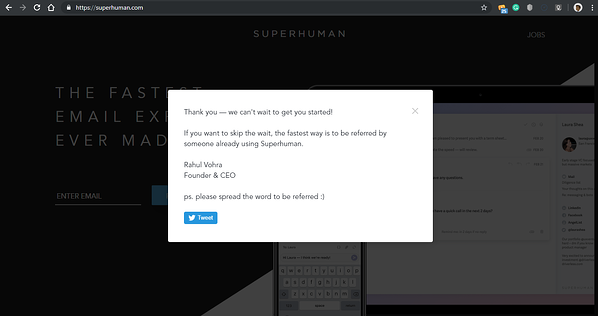
And while you’re reaching out on Twitter for an invite, you’re indirectly being an unpaid influencer for Superhuman.
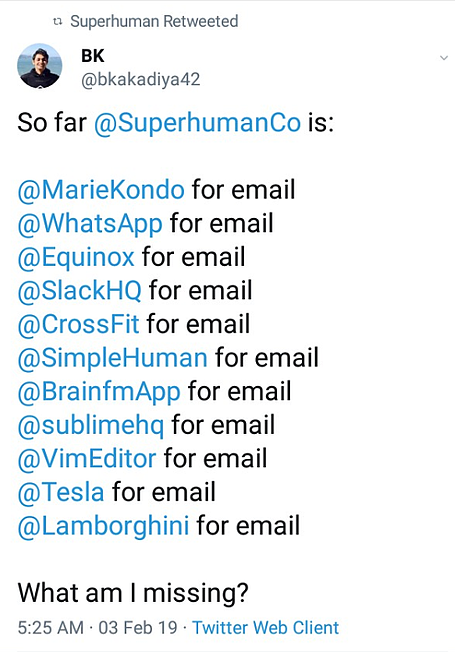
Influencer marketing
Google ‘Superhuman invite’ and you’ll find a bunch of tweets from VC and startup authorities who have shared Superhuman on Twitter.
Given that Superhuman is targeting high performance people who are looking to manage their inbox in less time, their demographic definitely includes startup founders and staff who suffer email overload. Combined with endorsements from the biggest, widely-followed names in the startup and venture capital world, Superhuman has leveraged the resulting media exposure to drive demand like rarely seen. Whether Superhuman is paying these influencers with cash, equity, or whether they’re just genuinely blown away with the product, their influence is no doubt playing a big part in Superhuman’s hypergrowth.
When you combine the immense power of social media with the influence of Silicon Valley’s brightest minds campaigning for an innovative Gmail alternative, Superhuman’s startup strategy is working.
Leverage FOMO | Monzo
Product Launch: 2011 | Funding: $772 million | Valuation: $3.5 billion
‘Shiny object syndrome’ or the fear of missing out (FOMO) is often identified as a focus killer in the startup world. But what if you could retarget FOMO to keep your users hooked?
Here’s how.
When Monzo set out to build an app-only digital bank, they knew they’d be up against serious competition from traditional banks that are considered secure and standard, as well as from existing smartphone banks.
That’s why they decided to gamify their waitlist. Instead of having users sign up and get notified when Monzo launched, they were shown their position on the Monzo waitlist and would be incentivized to move up some notches up on the waitlist. Of course, you’d have to grab a referral link and start inviting friends, who if they signed up, would get you a higher position on the Monzo rollout waitlist.


In effect, what the campaign achieved was to trigger a race to the top among their potential users who were desperate to grab first place on the waitlist. People jumped on board quickly, eventually snowballing until within 2 years, Monzo had acquired over 250,000 users.
Focus on inbound marketing to answer YOUR CUSTOMERS QUESTIONs | TransferWise
Product Launch: 2011 | Funding: $772 million | Valuation: $3.5 billion
TransferWise is a payment services provider that lets you send, receive and store money in 40+ currencies. When they launched in 2010, the payments field was already fielding several giants such as PayPal, WorldRemit, and of course, transnational banks that have kept a stranglehold on money transfers with exorbitant middleman rates.
The TransferWise team obviously did some intensive due diligence and realized that most times, whenever a prospect was looking for money transfer services, they’d head over to Google before deciding on an ideal payment solution.
Now, Google searches like ‘how to receive money in india’ or ‘how to transfer money to Canada’ show you this:
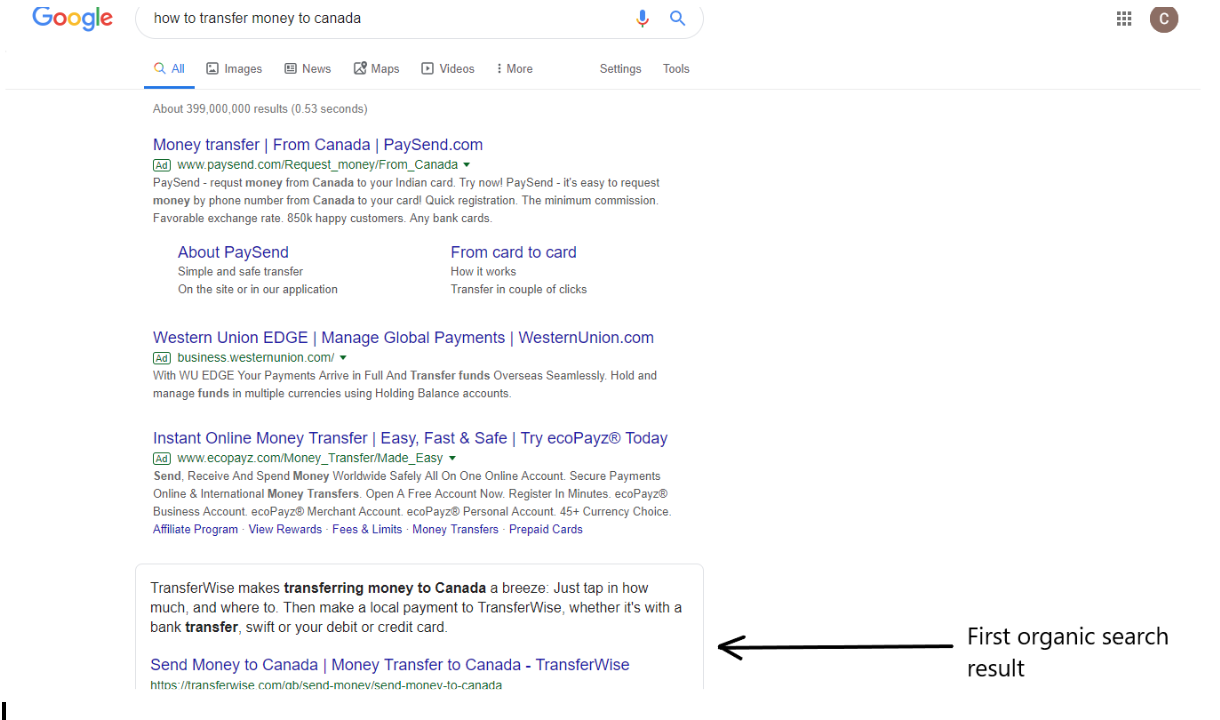
TransferWise focused on strategically hijacking these Google search results pages by consistently producing content their target customers would find relevant. The emphasis wasn’t on customer acquisition as much as it was on delivering helpful content that potential users would find useful.
According to TransferWise’s SEO and Organic Growth Manager, Fabrizio Ballarini, they’d examined scenarios where potential customers would eventually require money transfer help and they simply provided all the info they could find on the subject. Whether you’re looking to get info on paying back cross-border student loan, or looking to get a non-resident US bank account, TransferWise’s content would provide all the necessary information in one place.
That way, they could easily pivot to offering cheap and transparently priced money transfer services without friction.
What this emphasis on interactive content helped TransferWise achieve was that it:
- Boosted their SEO efforts to first-page levels. Google’s algorithm favours content that people actually find useful and spend time reading. The more often users click through to a specific link after searching for various keywords, Google recognizes the correlation and rewards you with a higher position.
- Lowered their customer acquisition costs since all they had to do was invest in content and ongoing SEO oversight. TransferWise now receives over a million visits from organic search
- Created an unbiased platform to pivot into offering cheap money transfer services
- Helped create a long-term customer acquisition avenue, and
- Boosted overall brand awareness
Most of this educational content lives on the TransferWise blog but the startup also engages in guest blogging opportunities where helpful content is shared on a high domain authority site, with links back to TransferWise’s site. This is an excellent backlink strategy.
Jumpstart awareness with pay-per-click ads
TransferWise knew it would take time for their educational content to rank, which is why they continue to invest in ad campaigns to jumpstart brand awareness. Using a tool like GrowthBot, we’re able to see which keywords businesses are bidding on in Google Ads. TransferWise bids on keywords like:
- “Wire transfer”
- “Money transfer”
- “Send money”
Running PPC ads is a great way to give you a head start while working on your content and SEO behind the scenes.
Sponsored content and guest blogging
TransferWise’s targeted content promotion covers a lot of reputable income advice websites where they’d publish guest posts addressing bugging personal finance issues, making sure to pivot to offering their cheaper, more convenient money transfer services.
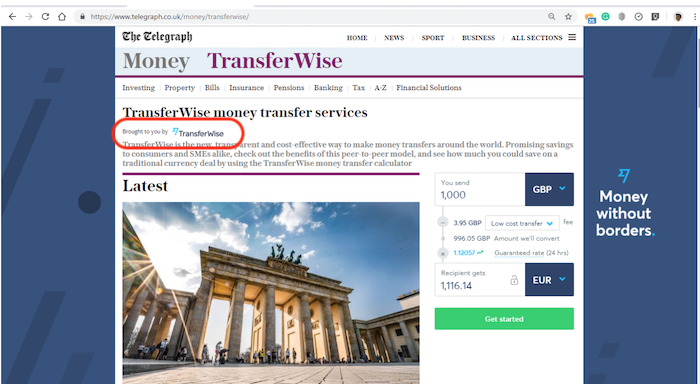
Sites like Telegraph, a widely-read news site in the UK have TransferWise features that point out the errors and costs associated with using other payment solutions, while pointing to TransferWise for their faster services and cheaper transfer costs. This enables them to shape the narrative that says,”TransferWise is the only payment solution that works just fine and doesn’t rip you off.”
When you factor in this extreme, almost guerilla emphasis on content marketing into TransferWise’s marketing, it increased their chances of getting seen when someone is looking to send money or receive money. Now it’s easy to see why within eight years, TransferWise has attracted over $700 million in funding and has hit an estimated $3.5 billion valuation.
Personalized website
TransferWise’s website content is completely personalized based on the user’s country. By identifying the IP address, visitors see relevant conversion rates in their home currency and even blog content specific to their location.
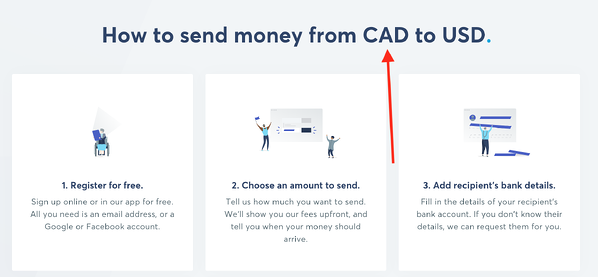
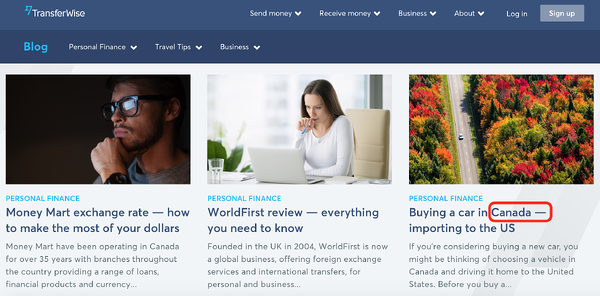 Custom content for each social media channel
Custom content for each social media channel
If you compare the posts businesses share across their Facebook, Twitter, Instagram, and LinkedIn channels, you’ll often see identical content duplicated across each.
But TransferWise recognized that the way people use these channels differ from platform to platform.
For example, people tend to use Instagram for entertainment and are reluctant to leave the app to read content. And people typically use Facebook to get recommendations from friends. Whereas Twitter is often used to find trending news.
TransferWise customizes the content they share based on the unique audience they’ve engaged on each social media platform.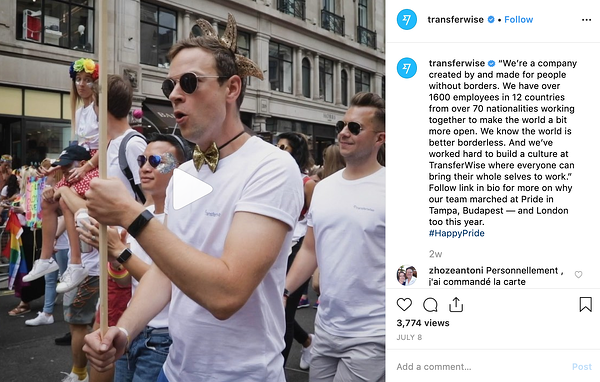
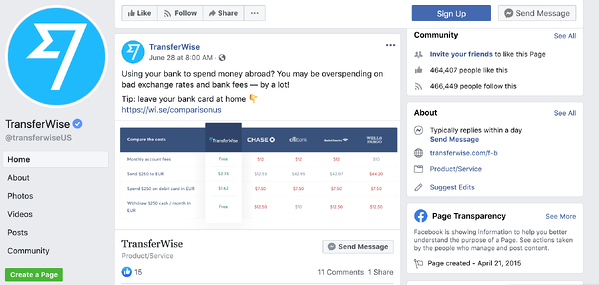
There's a common thread among these fast growing startups: they all understand their buyer personas and target audience extremely well. From the way they like to search for information, to the buzzwords they use, to the friction points they experience. Grab your template below and start building out your buyer personas!




